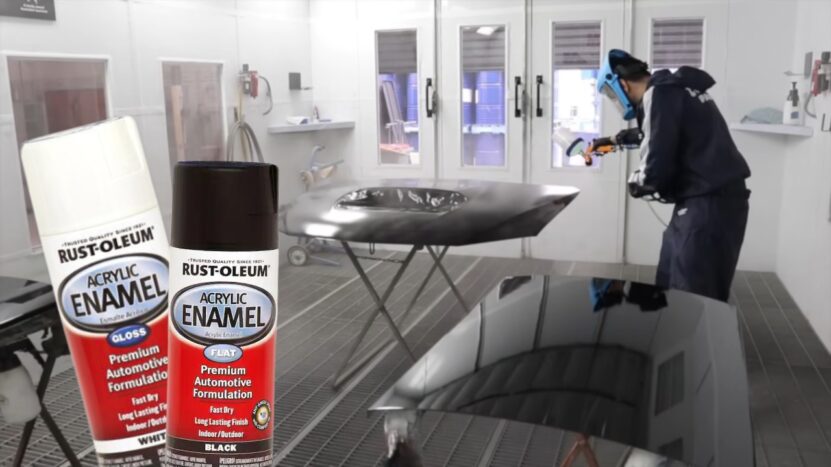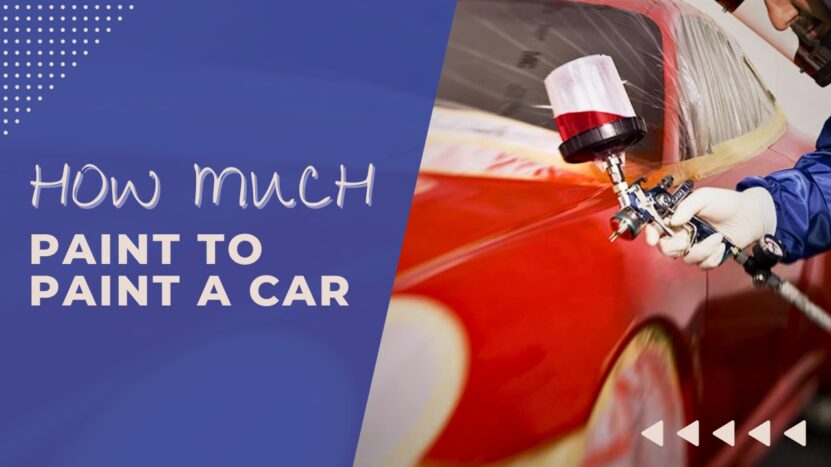If you’re thinking about giving your car a fresh, new look or perhaps restoring an old classic, you’ve come to the right place. In this article, we’ll discuss everything you need to know about automotive paint, including the types of paint, finishes, and how much of it you’ll need to get the job done.
Overview of Automotive Paint
Before you can begin painting your car, it’s essential to understand the different types of automotive paint available. By choosing the right kind, you’ll be able to achieve a professional finish that looks not only great but also provides long-lasting protection for your vehicle.
1. Primer
The first layer of paint you’ll apply to your car is the primer. Primer is crucial as it serves as a base for the subsequent layers of paint, ensuring proper adhesion and a smooth finish. It also provides some corrosion resistance and helps fill in small imperfections on the surface of the car. Generally, you’ll need around 1 to 2 gallons of primer for a standard-sized vehicle.
2. Basecoat
The basecoat is the primary color layer that gives your car its new appearance. This layer is usually applied in multiple coats to achieve the desired color and coverage. There are three main types of basecoat paints: acrylic lacquer, acrylic enamel, and urethane.
3. Acrylic Lacquer
Acrylic lacquer is a fast-drying paint that provides a high-gloss finish. It was popular in the automotive industry until the 1980s, but it’s now less commonly used due to its relatively low durability and susceptibility to damage from ultraviolet (UV) rays. However, it remains a popular choice for classic car restorations due to its ease of use and authentic appearance.
4. Acrylic Enamel

Acrylic enamel is a more durable and UV-resistant paint option that provides a glossy finish. It’s also easier to work with than acrylic lacquer and requires fewer coats to achieve full coverage. Acrylic enamel is a popular choice for both DIY enthusiasts and professional painters.
5. Urethane
Urethane is the most durable and long-lasting option, offering excellent UV protection, chemical resistance, and flexibility. This type of paint is more challenging to work with and requires specialized equipment, but it provides a professional finish that’s perfect for modern cars.
6. Clearcoat
The final layer is the clearcoat, which provides a protective layer over the basecoat. This layer adds depth and gloss to the finish and helps protect the paint from UV rays, scratches, and other environmental factors. You’ll typically need 1 to 2 gallons of clearcoat for a standard-sized vehicle.
Choosing the Right Finish
Now that you’re familiar with the different types of automotive paint, it’s time to discuss the various finishes available. Your choice of finish can have a significant impact on the final appearance of your car, so it’s essential to choose the right one for your project.
Gloss
A gloss finish is the most common choice for automotive paint, offering a smooth, shiny appearance. Gloss finishes are highly reflective, making them an excellent option for showcasing the curves and lines of your vehicle. They’re also easier to clean and maintain than other finishes.
Matte
Matte finishes have become increasingly popular in recent years, offering a unique, non-reflective appearance that stands out from the crowd. Matte finishes can be more challenging to maintain and are more susceptible to damage from scratches and UV rays, but they provide a distinctive look that’s hard to ignore.
Satin
Satin finishes fall between gloss and matte finishes, offering a slightly reflective surface with a silky texture. They’re less prone to showing dirt and imperfections than gloss finishes, but they still provide some shine and depth. Satin finishes are an excellent option for those seeking a balance between a glossy and matte appearance.
Metallic
Metallic finishes contain tiny metal flakes suspended in the paint, creating a sparkling effect when exposed to light. These finishes are particularly popular for sports cars and luxury vehicles, as they add depth and sophistication to the paint job. Metallic finishes can be more challenging to apply and may require additional clearcoat layers for optimal protection.
Pearlescent
Pearlescent finishes, also known as “pearl” finishes, are similar to metallic finishes but use mica particles instead of metal flakes. This creates a shimmering, iridescent effect that can change color depending on the angle and lighting conditions. Pearlescent finishes are often used on high-end vehicles and can create a truly stunning appearance.
How Much Paint Do You Need for a Car?
Now that you have a better understanding of the different types of paint and finishes available, it’s time to determine how much of it you’ll need for your project. The amount that is required can vary depending on several factors, including the size of your vehicle, the type of paint, and the desired finish.
1. Size of the Vehicle
The size of your vehicle plays a significant role. As a general rule, larger vehicles like trucks and SUVs will require more paint than smaller cars. Here are some rough estimates for different vehicle sizes:
- Compact car: 2-3 gallons of basecoat paint
- Midsize car: 3-4 gallons of basecoat paint
- Full-size car or small truck: 4-5 gallons of basecoat paint
- Large truck or SUV: 5-6 gallons of basecoat paint
Keep in mind that these are rough estimates, and the actual amount of paint required can vary depending on the specific make and model of your vehicle.
2. Type
The type of paint you choose can also impact the amount required for your project. As mentioned earlier, acrylic lacquer typically requires more coats than acrylic enamel or urethane type. This means that you may need to purchase more paint if you opt for acrylic lacquer.
3. Desired Finish
The desired finish can also affect the amount of paint you’ll need. For example, metallic and pearlescent finishes often require more coats than gloss, matte, or satin finishes. Additionally, if you’re aiming for a show-quality finish, you may need to apply more coats of paint to achieve the desired depth and appearance.
4. Paint Waste
When calculating how much paint you’ll need, it’s essential to account for waste. Some paint will inevitably be lost during the mixing, application, and cleanup processes. As a general rule, it’s a good idea to purchase 10-20% more than you think you’ll need to account for waste and potential touch-ups.
Tips for a Successful Job

To ensure the best possible results, keep these tips in mind as you embark on your car painting project:
1. Surface Preparation
Proper surface preparation is crucial for a successful paint job. Start by thoroughly washing your car to remove dirt, grease, and contaminants. Then, sand the surface to remove rust and imperfections. Be sure to use the appropriate grit sandpaper for the task and work your way from coarser to finer grits. After sanding, clean the surface with a wax and grease remover to ensure optimal paint adhesion.
2. Environment
The environment in which you paint your car can significantly impact the final result. Choose a well-ventilated, dust-free area to work in, ideally with a controlled temperature and humidity level. These factors can help prevent paint contamination and ensure it dries correctly.
3. Proper Mixing
Always follow the manufacturer’s instructions when mixing paint, primer, and clearcoat. The correct ratio of paint to thinner or reducer is critical for achieving a smooth, even finish. Additionally, be sure to use the appropriate hardeners and catalysts when required, as these can affect the curing and durability.
4. Spray Technique
When applying paint, use a consistent spray technique to achieve an even finish. Hold the spray gun parallel to the surface and maintain a consistent distance, typically 6-8 inches, while moving in smooth, overlapping passes. Apply multiple thin coats, allowing each coat to dry according to the manufacturer’s instructions before applying the next one.
5. Safety Precautions
Working with automotive paint can expose you to potentially harmful chemicals. Always wear appropriate personal protective equipment (PPE), such as a respirator, gloves, and goggles, when painting your car. Additionally, work in a well-ventilated area and follow all safety guidelines provided by the paint manufacturer.
6. Patience and Practice
Finally, remember that painting your car requires patience and practice. Don’t expect perfection on your first attempt – it takes time to develop the skills necessary to achieve a professional finish. If you’re new to automotive painting, consider practicing on a spare panel or scrap metal before tackling your car. This will help you familiarize yourself with the painting process and refine your technique.
Preparing your car’s surface through polishing before applying wax is an essential step in achieving a flawless finish and maximizing the longevity of your paint job.
Final Words
Painting your car is a rewarding and transformative process that can breathe new life into your vehicle. By understanding the different types, finishes, and the amount of paint required, you’ll be well-equipped to tackle your project like a pro.
Take the time to research and choose the right paint and finish for your specific needs, and don’t forget to account for waste when determining how much of it to purchase. With a little patience and attention to detail, you’ll soon have a car that not only looks fantastic but also provides long-lasting protection.

